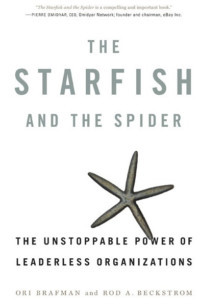 I just read a great book that I would suggest others read called The Starfish and The Spider, The unstoppable power of leaderless organizations by Ori Brafman and Rod Beckstrom (available everywhere including the ipad).
I just read a great book that I would suggest others read called The Starfish and The Spider, The unstoppable power of leaderless organizations by Ori Brafman and Rod Beckstrom (available everywhere including the ipad).
The book starts out by providing a chronicle of how science thinks the brain works. We have learned over the years that memories are not stored in one spot, but all over the brain – much like information indexed by Google is located all over the internet. As much as scientists wanted to hind heirarchy in the brain, it was not there – which makes the brain much more resilient.
Move this concept over to the online information industry and you have Napster, or Craigslist, or Skype – perhaps this is also true of real estate listings, which experts argue are “every where” today. Here is what else I picked up from the book that may encourage your reading interests.
The book provides a dozen or more examples of how the decentralization of leadership and information built stronger organizations. It seems counterintuitive that decentralized leadership would make organizations stronger, but the argument is compelling.
The crux of the book boils down to this
With a spider, what you see is what you get. A body, a head, 8 legs, etc. By contrast, a starfish is very different. It doesn’t have a head (metaphor for leader). Its central body isn’t even in charge. In fact, the major organs are replicated troughout each and every arm. If you cut the starfish in half, you’ll be in for a surprise: the animal won’t die, and pretty soon you’ll have two starfish to deal with.
I wonder if the same thing is not happening with listing syndication to third party websites. Everytime one gets cut off, 2 more appear in their place. We see this happen all over the world in powerful organizations. Consider the modern dilemma of terrorist cells. They are leaderless, driven by ideology. Every time a cell is eliminated, two more pop up in their place. The same thing happened with Napster – after it was shut down by courts, many more peer to peer sharing networks poped up to replace it that were even more decentralized (no servers at all, only client side).
As I turned the pages of the book, I could not help to draw parallels between the real estate industry (a well organized, and structured industry that moves very slowly) and the book’s example of the Katrina failure. By the time that hurricane relief needs worked its way to government leaders then back out to the thousands of rescue workers, it was too late. The people on the ground had the best knowledge and were in a better place to make decisions to help people, but the government organization stalled their efforts with bureaucracy.
I hope that you will read the book. It covers principals of decentralization like
1. Every time you try to decentralize a starfish organization, more organizations pop up behind it.
2. It is easy to mistake starfish for spiders
3. An open system doesn’t have central intelligence, the intelligence is spread throughout the system
4. Open systems can easily mutate
5. Decentralized organizations sneek up on you.
6. As industries become decentralized, overall profits decrease




